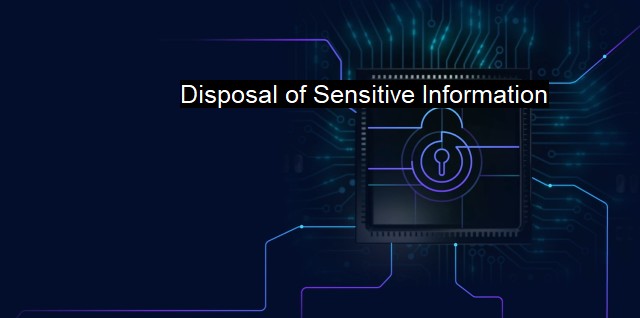What is Disposal of Sensitive Information?
Secure Disposal of Sensitive Information: Best Practices and Consequences in Cybersecurity and Antivirus
The disposal of sensitive information refers to the process of ensuring personal and confidential data is either completely destroyed or de-identified to avoid unauthorized access and misuse when the data is no longer needs to be maintained or stored. Sensitive information includes any data, whether paper or electronic, that can be used to cause harm or unauthorized alterations if it falls into wrong hands including personally identifiable information (PII), proprietary business details, financial records, and strategic reports among other confidential documents.In an age where cyber-attacks have become a significant threat to security, disposing of sensitive information has become a highly critical aspect of the world of cybersecurity and antivirus solutions. Data breaches can lead to critical consequences including not only financial losses but also damage to reputation that can take years to recover. These breaches are usually due to the neglected deletion of sensitive data. A proper disposal mechanism protects entities from lawsuits, heavy fines, as well as the loss of trust from customers and stakeholders that come from data breaches.
Sensitive data ranges from credit card details, personal client information, system logs, passwords, and medical records, to financial transaction records. Oftentimes, this is the information cybercriminals target to make illegal transactions, blackmail, unauthorized entry into databases, or to sabotage antagonist entities. Therefore, disposal of sensitive information not only averts these malicious activities, but it also potentially prevents identity theft, financial fraud, reputation damage, and loss of competitive advantage which could result from these breaches.
In the context of antivirus and cybersecurity, several methods have been developed to ensure the secure disposal of data. Software deletion, one such way, involves using overwriting software that repeatedly writes over the data that needs to be erased. This process makes it extremely difficult for the data to be recovered as the overwriting process is often recurring so the sensitive data is not reachable.
Physical destruction is another common method of secure data disposal. It involves physically shredding hard drives, disks, or any other forms of physical media where sensitive data is stored. This is done using specific high-strength shredding machines that make data reconstruction virtually impossible.
Another method is Degaussing, a process that eradicates files and renders hard drives unusable by eliminating its magnetic field. in cloud computing, data sanitization strategies are employed to de-identify data or expunge it completely using robust algorithms and policies.
For sensitive data that needs retention over a certain period due to regulations or business needs, encryption becomes a valuable tool. This doesn't erase data but instead cloaks the original data with unique code, therefore rendering it unreadable even if it does get intercepted.
Even with these methods at disposal, the real challenge is to perform the disposal process correctly in a way that leaves no loopholes for data leaks. This is where the importance of adhering to strict disposal policies comes. Policies identifying when and how data should be de-identified or destroyed should be well-defined and followed. Access controls, regular audits on disposal mechanisms, robust incident response plans, data disposal certifications, and continuous security awareness training can aid in mitigating threats to sensitive data.
The disposal of sensitive information is a comprehensive, systematic, and necessary practice in cybersecurity frameworks - indispensable in the era of digitization. As the links in a chain are interlocked, the smallest lapse in efforts to dispose of sensitive information can prove fatal, causing concessions that could put businesses at irreparable risk. Organizations need not just antivirus systems and firewalls, but structured data disposal methods to ensure uncompromised security and trustworthiness.

Disposal of Sensitive Information FAQs
What is considered sensitive information in terms of cybersecurity and antivirus?
Sensitive information in terms of cybersecurity and antivirus includes any data that could pose a threat to an individual or organization if it fell into the wrong hands. This may include personal identifying information, financial records, health records, intellectual property, or any information that could be used for malicious purposes.Why is proper disposal of sensitive information important in cybersecurity?
Proper disposal of sensitive information is important in cybersecurity because it helps prevent unauthorized access to valuable data. If sensitive information is not securely disposed of, it could be retrieved and used by cyber criminals to commit fraud, identity theft, or other types of cyber attacks.What are some methods for disposing of sensitive information securely?
Methods for disposing of sensitive information securely may include shredding paper documents, wiping hard drives and other storage media, or using a professional destruction service. It is important to ensure that any method used is compliant with local regulations and industry standards for data disposal.What steps can individuals or organizations take to ensure proper disposal of sensitive information?
Individuals or organizations can take several steps to ensure proper disposal of sensitive information, including implementing a data retention policy, training employees on proper data disposal procedures, and regularly reviewing and updating their cybersecurity protocols. It is also important to work with reputable cybersecurity and antivirus providers to ensure that data is properly protected throughout its lifecycle.| | A | | | B | | | C | | | D | | | E | | | F | | | G | | | H | | | I | | | J | | | K | | | L | | | M | |
| | N | | | O | | | P | | | Q | | | R | | | S | | | T | | | U | | | V | | | W | | | X | | | Y | | | Z | |
| | 1 | | | 2 | | | 3 | | | 4 | | | 7 | | | 8 | | |||||||